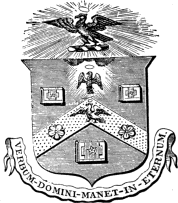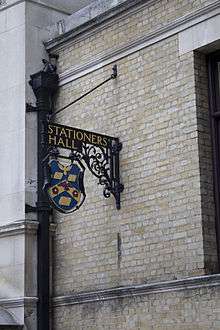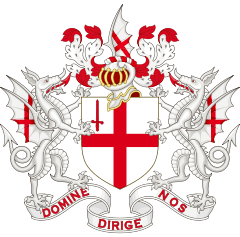Worshipful Company of Stationers and Newspaper Makers
 | |
| Location | Stationers' Hall, London |
|---|---|
| Date of formation | 1403 |
| Company association | Printing and publishing |
| Order of precedence | 47th |
| Master of company | Ian Bennett |
| Motto | Verbum Domini Manet In Aeternum |
| Website |
stationers |
The Worshipful Company of Stationers and Newspaper Makers (until 1937 the Worshipful Company of Stationers) (usually known as the Stationers' Company) is one of the Livery Companies of the City of London. The Stationers' Company was formed as an organisation in 1403; it received a Royal Charter in 1557. It held a monopoly over the publishing industry and was officially responsible for setting and enforcing regulations until the enactment of the Statute of Anne in 1710. Once the Company received its Charter, “the Company’s role was to regulate and discipline the industry, define proper conduct and maintain its own corporate privileges.”[1]
Its members (Master, Wardens, Assistants, Liverymen, Freemen and Apprentices) are mostly involved with the modern visual and graphic communications industries which have evolved from the company's original trades. These include printing, papermaking, packaging, office products, engineering, advertising, design, photography, film and video production, publishing of books, newspapers and periodicals and digital media. The Company's principal purpose nowadays is to provide an independent forum where its members can advance the interests (strategic, educational, training and charitable) of the industries associated with the Company.
History
In 1403, the Corporation of London approved the formation of a Guild of Stationers. At this time, stationers were either text writers, lymners (illuminators), bookbinders or booksellers who worked at a fixed location (stationarius) beside the walls of St Paul's Cathedral.[2] Booksellers sold manuscript books, or copies thereof produced by their respective firms for retail; they also sold writing materials. Illuminators illustrated and decorated manuscripts.
Printing gradually displaced manuscript production so that, by the time the Guild received a Royal Charter of Incorporation on 4 May 1557, it had in effect become a Printers' Guild. In 1559, it became the 47th in City Livery Company precedence. At the time, it was based at Peter's College, which it bought from St Paul's Cathedral. During the Tudor and Stuart periods, the Stationers were legally empowered to seize "offending books" that violated the standards of content set down by the Church and State; its officers could bring "offenders" before ecclesiastical authorities, usually the Bishop of London or the Archbishop of Canterbury depending on the severity of the transgression. Thus the Stationers played an important role in the culture of England as it evolved through the intensely turbulent decades of the Protestant Reformation and toward the English Civil War.
The Stationers' Charter, which codified its monopoly on book production, ensured that once a member had asserted ownership of a text (or "copy") no other member was entitled to publish it. This is the origin of the term "copyright", but which is a distinctly different right to our modern conception of copyright (ie the stationers' 'copy right' was a protection granted to printers, where 'copyright', introduced with the Statute of Anne is a right granted to authors). Members asserted such ownership by entering it in the "entry book of copies" or the Stationers' Company Register. The Register of the Stationers' Company became one of the most essential documentary records in the later study of English Renaissance theatre.[3] (In 1606 the Master of the Revels, who was responsible for licensing the performance of plays rather than their publication, acquired some overlapping authority over publication as well; but the Stationers' Register remained a crucial and authoritative source of information after that date too.) To be sure, enforcement of the rules was always a challenge, in this area as in other aspects of the Tudor/Stuart regime; and plays and other works were sometimes printed surreptitiously and illegally.
In 1603, the Stationers formed the English Stock, a joint stock publishing company funded by shares held by members of the Company. This profitable business gained many patents of which the richest was for almanacks including Old Moore's Almanack. The business employed out-of-work printers and disbursed some of the profit to the poor.
In 1606, the Company bought Abergavenny House in Ave Maria Lane and moved out of Peter's College. The new hall burnt down in the Great Fire of 1666 along with books to the value of about £40,000. It was rebuilt and its present interior is much as it was when it reopened in 1673. The Court Room was added in 1748 and in 1800 the external façade was remodelled to its present form.
In 1695, the monopoly power of the Stationers' Company was diminished, and in 1710 Parliament passed the Copyright Act 1709, the first copyright act.
The Company established the Stationers' Company's School at Bolt Court, Fleet Street in 1861 for the education of sons of members of the Company. In 1894, the school moved to Hornsey in north London. It closed in 1983.
Registration under the Copyright Act 1911 ended in December 1923; the Company then established a voluntary register in which copyrights could be recorded to provide printed proof of ownership in case of disputes.
In 1937, a Royal Charter amalgamated the Stationers' Company and the Newspaper Makers' Company, which had been founded six years earlier (and whose members were predominant in Fleet Street), into the Company of the present name.
The Company's motto is Verbum Domini manet in aeternum, Latin for The Word of the Lord endures forever.
Stationers' Hall

Stationers' Hall is at Ave Maria Lane near Ludgate Hill. The site of the present hall was formerly Abergavenny House, which was purchased by the Stationers in 1606 for £3,500, and destroyed in the Great Fire of London, 1666.[4] The building and hall date from circa 1670. The hall was remodelled in 1800 by the architect Robert Mylne and, on 4 January 1950, it was designated a Grade I listed building.[5][6]
Notable liverymen
- Edward Allde
- Anthony Bailey
- John Cleave
- Thomas Cotes
- George Eld
- Edmund Evans
- George Faulkner
- Richard Field
- Augustine Matthews
- George Mudie (Owenite)
- Rupert Murdoch
- Thomas Cautley Newby
- Nicholas Okes
- Peter Short
- William Stansby
- John Trundle
- Sir Christopher Meyer
- David Starkey
See also
References
- ↑ Lyons, Martyn (2011). Books: A Living History. Los Angeles, CA: J. Paul Getty Museum. p. 61.
- ↑ Patterson, Lyman Ray (1968). Copyright in Historical Perspective. Vanderbilt University Press.
- ↑ Chambers, E. K. (1923). The Elizabethan Stage. 4 Volumes, Oxford, Clarendon Press; Vol. 3, pp. 160-77, 186-91.
- ↑ Stationers Livery Company website. Accessed 17 February 2015
- ↑ Historic England. "Details from image database (199293)". Images of England. accessed 23 January 2009
- ↑ Cyprian Blagden (1977) [1960]. "The Property". The Stationers' Company: A History, 1403-1959. Stanford University Press. ISBN 9780804709354.
Further reading
- Charles Knight, ed. (1844), "Stationers' Company", London, 6, London: C. Knight & Co.
- John Gough Nichols (1861), Historical notices of the worshipful Company of stationers of London, OCLC 5386736
- Sketch of the History and Privileges of the Company of Stationers. 1871.
- Edward Arber, ed. (1875–1877), Transcript of the Registers of the Company of Stationers of London, 1554-1640 A.D.
- "Stationers' Hall", Handbook to London as It Is, London: J. Murray, 1879
- Charles Robert Rivington (1883), Records of the Worshipful Company of Stationers, Nichols and Sons, OCLC 19943126
- G. E. B. Eyre and C. R. Rivington, ed. (1913–1914), Transcript of the Registers of the worshipful Company of Stationers, from 1640-1708 A.D. + v.2-3
- "Stationers' Hall", London and Its Environs (17th ed.), Leipzig: Karl Baedeker, 1915
- W. W. Greg, The Decrees and Ordinances of the Stationers' Company, 1576-1602 (1928)
- W. W. Greg and E. Boswell, Records of the Court of the Stationers' Company, 1576 to 1602 - from Register B (1930)
- Fred S. Siebert, "Regulation of the Press in the Seventeenth Century: Excerpts from the Records of the Court of the Stationers' Company," Journalism Quarterly, XIII (1936), 381-93.
- Graham Pollard (1937), "Company of Stationers before 1557", The Library, 18, ISSN 1744-8581,
Library Association
- Graham Pollard (1937), "Early Constitution of the Stationers' Company", The Library, 18
- Cyprian Blagden (1957), "Accounts of the Wardens of the Stationers' Company", Studies in Bibliography, 9, JSTOR 40371196
- Cyprian Blagden (1957), "English Stock of the Stationers' Company in the Time of the Stuarts", The Library, 12
- W. A. Jackson, Records of the Court of the Stationers' Company, 1602 to 1640 (1957)
- Cyprian Blagden (1958), "Stationers' Company in the Civil War Period", The Library, 13
- Cyprian Blagden (1959), "Stationers' Company in the Eighteenth Century", Guildhall Miscellany, ISSN 0072-8985
- Cyprian Blagden (1960). The Stationers' Company: A History, 1403-1959. London: Allen & Unwin. OCLC 459559508.
- D. F. McKenzie (ed.), Stationers' Company Apprentices, 1605-1800 in three volumes: 1605-1640, 1641-1700 and 1701-1800. (Charlottesville: Bibliographical Society of the University of Virginia, 1961; Oxford: Oxford Bibliographical Society, 1974 and 1978)
- Robin Myers (1985), Robin Myers and Michael Harris, ed., "The Financial Records of the Stationers' Company, 1605-1811", Economics of the British Booktrade 1605-1939, Cambridge: Chadwyck-Healey, ISBN 0859641694
- The Stationers' Company Archive: An Account of the Records, 1554-1984 by Robin Myers (Winchester: St Paul's Bibliographies, 1990).
- C.Y. Ferdinand (1992), "Towards a Demography of the Stationers' Company 1601-1700", Journal of the Printing Historical Society, 21, ISSN 0079-5321
- Robin Myers and Michael Harris, ed. (1997), Stationers’ Company and the Book Trade 1550-1990, Winchester: St Paul’s Bibliographies, ISBN 9781873040331
- Robin Myers, ed. (2001), Stationers’ Company: a history of the later years 1800-2000, Chichester: Phillimore & Co., ISBN 9781860771408
- Peter Blayney (2003), Stationers’ Company before the Charter, 1403-1557, London: Worshipful Company of Stationers and Newspaper Makers, OCLC 52634009
External links
| Wikimedia Commons has media related to Worshipful Company of Stationers and Newspaper Makers. |
| Wikisource has original text related to this article: |
